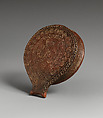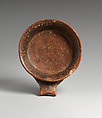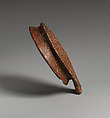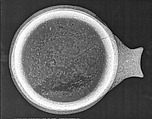On loan to The Met The Met accepts temporary loans of art both for short-term exhibitions and for long-term display in its galleries.
Terracotta frying pan
Technical Analysis: Ultraviolet-induced visible luminescence examination, optical microscopy, X-ray radiography
This nearly intact cylindrical, open vessel has a slightly convex decorated base with low walls that taper outward, and a short, broad handle that lends it the appearance of a frying pan. The base and handle are conceived as one piece that protrudes beyond the short walls with a vertical rounded rim. The short handle, forked at the end, rises at an oblique angle from the base.
The underside of the base is covered with a dense stamped and incised decoration. Bands of geometric and curvilinear themes rendered by hand are separated by incised lines and filled with kaolin. Pairs of stamped triangles with reverse tips follow the outline of the handle and base. A band of stamped spirals separates the outer band from another one stamped with reversed triangles. In the center of the base is a partially preserved design featuring a central spiral from which radiate two stamped bands of reversed triangles. In between the radials are more stamped spirals. This type of vessel is discussed in detail by J. E. Coleman.(1) The clay and the decoration look similar to examples from Syros.(2)
The vessel is made of a micaceous red clay. There are traces of beige burial accretions in recessed areas of the decoration and on an older loss on the rim near the handle, as well as in the pitted area below the opposite interior rim. The surface of the vessel is worn with scattered scrapes, scratches and small chip losses. One long crack extends from the lip near the handle toward the center of the vessel. Multiple additional cracks are visible on the interior. A chipped area on the decorated base was restored with smoother pinkish-red fill. Since the fill material is less dense than the terracotta, the restored area appears darker or less opaque on the X-ray image.
Georgios Gavalas and Linda Borsch
(1) J.E. Coleman, 1985. “Frying pans of the Early Bronze Age Aegean,” American Journal of Archaeology, 89.2, 191-219, where similar examples are discussed and illustrated, see pl.36, fig. 19, pl. 37, fig. 31.
(2) See also J. Ramstorf , Kykladen I, Die fruehe Bronzenzeit Grab und Siedlungsbefuende, Bonn 2000, Syros, Chalandriani grave 377, Athens NAM 5153, Taf.55.1. p.123, Taf. 131.1.
#1338: Terracotta frying pan
This image cannot be enlarged, viewed at full screen, or downloaded.
This artwork is meant to be viewed from right to left. Scroll left to view more.






